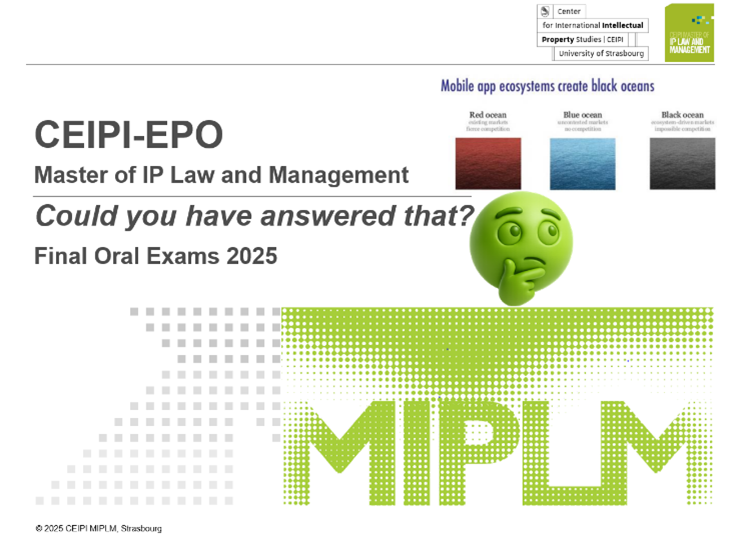Could you have answered that? Cracking the CEIPI EPO MIPLM’25 Exam on IP in Digital Business Transformation
Task 23 of the CEIPI-EPO MIPLM’25 exam challenges candidates to explain the role of IP in digital business transformation.
The exam question
DigiMach GmbH, a traditional mechanical engineering company, is undergoing a digital transformation. The company is shifting its value proposition from selling machines to offering connected, data-driven services such as predictive maintenance, remote monitoring, and digital twins. The management has realized that their traditional patent-centered IP strategy is not well suited for the new business model. Software, data, and user experience now play a central role, and they are unsure how to protect and commercialize these assets.
You are hired as an IP management consultant to realign DigiMach’s IP strategy with its digital business transformation. Present how IP protection must evolve to support digital value creation. Describe suitable protection strategies for data, software, and platforms, and explain how IP can secure digital business models. Consider the implications of ecosystem innovation and software patentability under the EPC.
Here you find the 🔎IP Management Glossary entry on Business Model
Here you find the 🔎IP Management Glossary entry on Digital Business Ecosystem
What the lecture on digital business transformation teaches
Module 6 of the CEIPI MIPLM program explores how digital transformation reshapes business models and redefines the role of IP in value creation. The lecture begins with an overview of key technology trends driving this transformation: generative AI, immersive environments, data-centric services, advanced computing, and the convergence of physical and digital product features. These changes not only enable new services, but also demand entirely new ways to manage innovation and protect assets.
One of the central insights is that digital business models often revolve around intangible assets—software, platforms, data, and user experience. These assets are difficult to protect with traditional patent strategies alone. The transformation requires IP professionals to think beyond conventional technical inventions and address the legal protection of modular, rapidly iterated, and co-developed components.
The lecture emphasizes that IP is not simply a defensive mechanism in this context, but a strategic enabler. If used correctly, IP supports monetization models such as licensing, pay-per-use, and platform access fees. It also builds trust among partners in ecosystems by defining rights, obligations, and boundaries around shared innovation.
Another important theme is the need to align IP strategy with agile development practices. Digital innovation is often iterative, fast-paced, and decentralized. Without appropriate mechanisms, inventions can be disclosed too early, assets may not be properly documented, and IP ownership may be unclear—especially when collaborating with external development partners.
The European perspective on software patentability under the EPC also features prominently in the lecture. Only software with a technical effect is patentable. Administrative processes, business methods, or purely intellectual activities are excluded. This requires IP managers to collaborate closely with developers to identify and describe technical contributions in a way that meets EPO examination criteria.
Finally, the lecture addresses the complexity of IP in ecosystems and platform models. With many contributors and users interacting through a shared digital infrastructure, governance becomes key. Questions of co-ownership, data access, interoperability, and contractual IP control must be addressed early in the business design.
Which IP experts explore this topic on the IP Business Academy
- Sebastian Goebel, Patents in the Digital Age
- Oliver Baldus, How Lean IP Revolutionizes IP Management
- Hannes Burger and Daniel Holzner, AI-assisted invention processes
- Erdem Kaya: Software Patenting and IP Management
- Robert Klinski: Systematic Invention Harvesting
Learners can find deep dives, articles, and even webinars on:
- Digital IP Lexicon 🔗dIPlex on IP in the Digital Transformation
- 📑 IP Management Letter: IP as a strategic lever in Ecosystem Business Models
- Here you find the 🔎IP Management Glossary entry on Platform Business IP Management
- Here you find the 🔎IP Management Glossary entry on Licensing-Based Business Models
Sample solution to the exam question
To support DigiMach GmbH’s digital transformation, the IP strategy must be redesigned from the ground up. Traditional patents for hardware inventions and mechanical features are no longer sufficient. The focus must now include intangible, software-based, and collaborative innovations. The new IP approach must integrate protection, business model support, and strategic alignment with the digital transformation roadmap.
- IP must be repositioned as a value enabler. In the new business model, DigiMach no longer sells machines but offers digital services based on data collection, analysis, and system connectivity. These services depend on proprietary software, analytics algorithms, predictive models, and user interfaces. IP protection should therefore secure exclusivity over the critical elements of this new value chain: the embedded software in machines, the backend data processing logic, and the frontend user experience.
- Software protection requires a multi-layered strategy. Patent protection is available for software innovations if they solve a technical problem. This includes control algorithms for machinery, data compression techniques, or secure communication protocols. The European Patent Convention demands that the technical contribution be clearly defined in the claim structure and not merely presented as part of a business method. Patentability must be assessed early, and invention disclosures should document the technical challenge and solution explicitly.
- Source code and visual elements are covered by copyright. This protection arises automatically and secures original expressions such as specific UI layouts, visualization tools, and the codebase itself. However, it does not prevent reverse engineering unless coupled with contractual or trade secret safeguards.
- Trade secrets are essential in protecting algorithms, training data for AI models, and performance optimization routines. These assets may be difficult or impossible to patent but are key to service differentiation. Internal policies and technical safeguards must be implemented to ensure confidentiality and controlled access. This includes encryption, logging, and NDAs with development partners.
- Design rights are another relevant tool, particularly for user interfaces and dashboards. They can be used to protect visual identity and interaction logic, especially when distinctive and valuable from a customer experience standpoint.
The new business model may also involve trademarks to build trust and brand recognition around the digital services. This includes the naming of platforms, proprietary analytics engines, or machine dashboards that are marketed as signature features.
A central challenge is the integration of IP into platform-based innovation. DigiMach may find itself co-developing solutions with software vendors, customers, or service partners. This introduces shared IP risks. Co-created features must have clear ownership structures, and licensing frameworks should specify which rights are transferred, retained, or jointly exploited. These terms should be negotiated early in platform design to avoid disputes or lock-in.
Data usage also raises legal and strategic questions. If DigiMach collects data from customers’ machines to generate predictive insights, who owns the data? Can it be reused for model training? Does the customer retain control? IP strategy here must be closely linked to data governance, contract law, and customer relationship management.
Agile development methodologies introduce additional complexity. Iterative sprints, continuous integration, and MVP releases can undermine the documentation and timing needed for effective IP capture. To manage this, IP professionals must be embedded in agile workflows. They can set up fast-track disclosure processes, conduct periodic IP reviews during sprints, and use tooling to monitor code changes for originality and risk.
To summarize, DigiMach’s digital transformation calls for an IP strategy that is holistic, adaptive, and integrated into the business. The following pillars should guide implementation:
- Identify and prioritize core digital assets: embedded software, analytics, interfaces, data structures, and service frameworks.
- Apply a layered protection model combining patents (for technical effects), copyrights (for expression), trade secrets (for know-how), designs (for visual elements), and trademarks (for service identity).
- Address IP governance in ecosystem relationships through contracts, licensing models, and clear ownership definitions.
- Build confidentiality and IP processes into agile development environments to ensure timing, quality, and compliance.
- Align IP strategy with digital monetization models—such as licensing, subscriptions, and data-as-a-service—to ensure that IP is actively supporting revenue generation.
By doing so, DigiMach can secure competitive advantage in its new digital role, protect its service differentiation, and build the trust required to collaborate in evolving industrial ecosystems. The company’s transformation is not only about adopting digital tools, but also about adopting a new mindset toward value creation—and IP is central to that shift.
And that’s the kind of thinking that could help you pass the MIPLM oral exam—and more importantly, shape the future of IP management.



